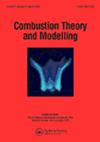湍流反应流区域自适应建模的粒子/有限体积混合算法中的一致子模型耦合
IF 1.6
4区 工程技术
Q4 ENERGY & FUELS
引用次数: 1
摘要
本文提出了一种混合粒子/有限体积算法,用于紊流反应流的区域自适应建模,以实现高保真度的预测和高效率的计算。具体而言,采用基于有限体积算法的计算经济物种输运模型作为整个计算域的基础模型,而基于拉格朗日粒子跟踪的高级输运概率密度函数(TPDF)方法仅用于湍流-化学相互作用强烈的区域。“PDF区域”可以根据局部流动和火焰特性动态更新,并且与复杂的几何结构(如分离的多块、非凸和多连接区域)兼容。建立了粒子/有限体积的双向耦合子模型,以保证PDF区域内子模型成分的一致性,并在PDF区域边界上施加正确的成分和质量流率的界面条件。研究了时变PDF区域的空间划分和粒子算法,并研究了自适应模型的收敛特性,特别是统计误差和偏差随每个单元粒子数的变化。提出的区域自适应混合粒子/有限体积算法在湍流氢/空气非预混射流火焰中得到了数值验证。结果表明,区域自适应模型的预测结果与单独的TPDF模型的预测结果几乎相同,这表明在保持预测精度的同时,计算成本显著降低。本文章由计算机程序翻译,如有差异,请以英文原文为准。
Consistent submodel coupling in hybrid particle/finite volume algorithms for zone-adaptive modelling of turbulent reactive flows
A hybrid particle/finite volume algorithm has been formulated for zone-adaptive modelling of turbulent reactive flows to achieve both high fidelity in predictions and high computational efficiency. Specifically, a computationally economical species transport model via finite volume algorithm is employed as the base model for the whole computational domain, while the advanced transported probability density function (TPDF) method via Lagrangian particle tracking is employed only for regions with intense turbulence-chemistry interaction. The ‘PDF regions’ can be updated dynamically based on local flow and flame characteristics, and are compatible with complex geometric structures such as separated multi blocks, non-convex, and multi-connected regions. A two-way particle/finite volume submodel coupling is formulated to ensure the composition consistency in submodels in the PDF regions and to impose the correct interface conditions for composition and mass flow rate on the boundary of the PDF regions. The spatial partition and particle algorithms for time-varying PDF regions are demonstrated and the convergence characteristics of the adaptive modelling are investigated specifically for the variation of statistical error and bias with the number of particles per cell. The proposed zone-adaptive hybrid particle/finite volume algorithm has been numerically validated in a turbulent hydrogen/air non-premixed jet flame. It is shown that the predictions from zone-adaptive modelling are almost identical to those of stand-alone TPDF, illustrating the preservation of prediction accuracy but with significantly less computational cost.
求助全文
通过发布文献求助,成功后即可免费获取论文全文。
去求助
来源期刊

Combustion Theory and Modelling
工程技术-工程:化工
CiteScore
3.00
自引率
7.70%
发文量
38
审稿时长
6 months
期刊介绍:
Combustion Theory and Modelling is a leading international journal devoted to the application of mathematical modelling, numerical simulation and experimental techniques to the study of combustion. Articles can cover a wide range of topics, such as: premixed laminar flames, laminar diffusion flames, turbulent combustion, fires, chemical kinetics, pollutant formation, microgravity, materials synthesis, chemical vapour deposition, catalysis, droplet and spray combustion, detonation dynamics, thermal explosions, ignition, energetic materials and propellants, burners and engine combustion. A diverse spectrum of mathematical methods may also be used, including large scale numerical simulation, hybrid computational schemes, front tracking, adaptive mesh refinement, optimized parallel computation, asymptotic methods and singular perturbation techniques, bifurcation theory, optimization methods, dynamical systems theory, cellular automata and discrete methods and probabilistic and statistical methods. Experimental studies that employ intrusive or nonintrusive diagnostics and are published in the Journal should be closely related to theoretical issues, by highlighting fundamental theoretical questions or by providing a sound basis for comparison with theory.
 求助内容:
求助内容: 应助结果提醒方式:
应助结果提醒方式:


